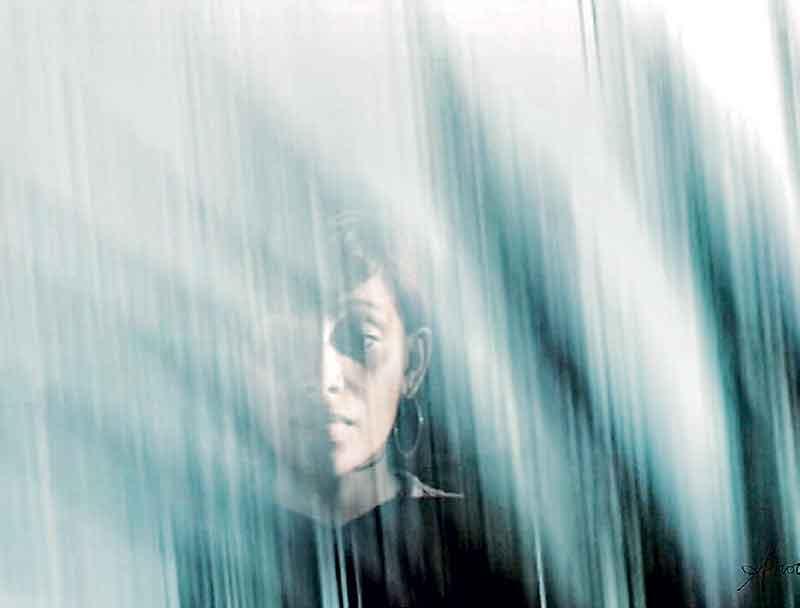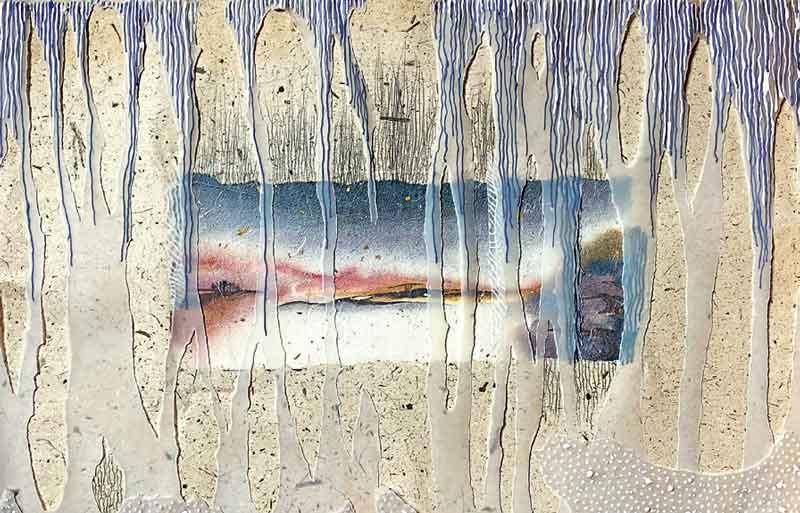And she will mark every child with the Ash of her shawl
Nature, with its beauty, resilience, and permanence, is essential to my sense of peace and creativity. I feel most at home and at peace in the sea, though after the tsunami, I couldn’t even look at it for two years.
 As part of the Sri Lanka Design Festival under the banner of Mercedes Benz Art celebrated artist Anoma Wijewardene will be one of three speakers addressing the salient topic of Art and Women as a catalyst for change. Additionally her work will also be displayed at the Mercedes Benz Lounge at Cinnamon Life city of dreams. In this thought provoking interview anoma speaks about how art can amplify the struggles and triumphs of women and gender empowerment.
As part of the Sri Lanka Design Festival under the banner of Mercedes Benz Art celebrated artist Anoma Wijewardene will be one of three speakers addressing the salient topic of Art and Women as a catalyst for change. Additionally her work will also be displayed at the Mercedes Benz Lounge at Cinnamon Life city of dreams. In this thought provoking interview anoma speaks about how art can amplify the struggles and triumphs of women and gender empowerment. Q:Your work is a profound celebration of women’s resilience in the face of devastation. What was the inspiration behind this theme, and how do you believe art can amplify the struggles and triumphs of women today?
Q:Your work is a profound celebration of women’s resilience in the face of devastation. What was the inspiration behind this theme, and how do you believe art can amplify the struggles and triumphs of women today?
Inspiration may be part of it, but it’s primarily astonishment, sorrow, and a profound sense of injustice that drives me. In 2024, when many women are shattering glass ceilings and excelling in various fields, and a minority woman is running for the highest office, it is painful to see how many still struggle for equality. In many countries, violence against women has risen, both in their homes and on the streets, and their freedom of choice remains restricted by patriarchal systems. Art may not resolve these issues, but it has the power to influence in subtle, pervasive ways by reaching hearts where raw facts often cannot. As an artist, this is my tool for addressing these concerns. I may not march in protests as I did in my youth, but I continue to advocate from my studio.
Q: As an artist, how do you navigate the tension between representing the progress women have made and the ongoing challenges they face, such as violence, misogyny, and limited freedoms in certain societies?
There is much to celebrate in the progress and hard-won victories achieved by women, yet it is especially painful to witness the setbacks. In these post Me Too times, when women are ascending to high offices, they still face misogyny. In some regions, rights that women fought for, like reproductive freedom, have been revoked in recent years. It’s a difficult dichotomy to navigate—many women are in the best of times, while for others, the struggle has intensified.
This earth is our body. Each cerulean sea swells through our veins, searching for a horizon at the edge, of skin-rock and bone-sand

We discover we are made of glass
Q: Your exhibition is featured under the Mercedes-Benz Art umbrella at the festival. How do you feel this platform helps elevate the conversation around gender and empowerment through art?
I am honoured and deeply grateful for this invitation from Mercedes-Benz Art and the Sri Lanka Design Festival. I hope this visibility and positioning will bring attention to women’s empowerment and perhaps even galvanize action. This exhibition, which celebrates women’s resilience, under their umbrella could suggest inclusivity and their commitment to supporting women’s empowerment.
|

May you be at peace
|
Q: The visual language in your work often focuses on renewal and transformation. Could you explain how these concepts reflect not only individual experiences but also broader societal shifts?
Thank you for recognizing this. The theme of transformation has underscored my work for decades. Whether addressing the climate crisis or unity in diversity, transformation is the foundation. Broad societal shifts stem from the personal journeys of transformation each of us undertakes—the realization that we must change ourselves before we can change the world. Each person contributes in their own way, using their own skills. For me, that contribution comes through art, a journey I believe each of us is responsible for in our unique way.
Q: With gender-based violence rising globally, how do you approach such painful realities in your work while also maintaining a sense of hope and empowerment?
It is incomprehensible that, with women making up nearly half the world’s population, gender-based violence still exists and even escalates. Half the world is, in effect, treated as a minority. This reality is painful to witness daily. Art may not offer a solution, but it serves as a medium to express hope that change is possible. Hope is what sustains, inspires, and drives us forward.
Q: You mention that the fight for women’s freedom is only beginning. In what ways do you believe artists, particularly women, can contribute to this ongoing battle for equality?
It’s surprising to me that, decades after the feminist movements of the seventies, we still face these struggles. We must continue to push for equality actively. While you asked about women specifically, men—whether as sons, brothers, husbands, friends, or colleagues—are equally invested in this journey toward empowerment. I know men around the world who champion this cause, recognizing that equality uplifts everyone. United, we rise.
Q: How do you think women in creative industries like art and design can influence societal change compared to those in politics or other more traditionally male-dominated fields?
I believe women, and men, across fields—from boardrooms to parliaments—are addressing these issues. In the UK, for instance, the creative industry plays a crucial role in the economy and carries significant influence. Creative industries, often including a high proportion of women, can lead by example, driving the empowerment of women through innovation, visibility, and cultural impact.
Q:What role do you think cultural contexts play in the way art is perceived, especially when addressing sensitive issues like the oppression of women?
Art’s universality is its greatest strength; it speaks to the heart, mind, and soul. Its impact can be profound across diverse cultures. Some regimes may censor certain expressions of art that challenge political norms, yet art persists in finding ways to speak to forbidden truths, often through subtle, indirect means. Art’s ability to transcend cultural boundaries gives it a unique power to address oppression, even in repressive contexts.
Q: You highlight that the earth renews itself after every catastrophe, just as women do. How does nature inspire your artistic process, and how do you connect environmental themes with your focus on women?
Nature, with its beauty, resilience, and permanence, is essential to my sense of peace and creativity. I feel most at home and at peace in the sea, though after the tsunami, I couldn’t even look at it for two years. Thankfully, my connection with the sea has returned, much like the resilience of nature itself. The idea of woman and nature as one is ancient, present in archetypes like Mother Earth and Gaia. Women, like nature, embody resilience and regeneration.
Q:Looking at the future, what message do you hope this exhibition sends to the next generation of women artists, particularly those from South Asia?
In South Asia, as in many places, women can only reach their fullest potential by supporting and uplifting one another, across communities and families. The beauty of pure art, as a poet, composer, or artist, is that there are no defined roles—we create freely.
I’m not sure about delivering specific messages or answers, but perhaps the most important contribution my art can make is to ask the burning questions that resonate in our hearts.
Q: Your art also consistently explores critical social, political, and environmental challenges, particularly the climate crisis and reconciliation. What inspired you to focus on these themes, and how do you believe art can influence societal change?
Art may not directly drive change, but it has a unique ability to reach the heart, and that is where change truly begins. As an artist, one always holds hope. Of course, politicians and billionaires often hold the power to implement substantial changes. These themes aren’t just topics; they stem from a deep-seated anxiety and concern for our planet and humanity’s journey. They are profoundly personal reflections and questions.
Writers, graphic designers, composers, film directors, and actors. ‘Phoenix’ in 2009, marking the end of the war, had seven installations that required collective effort. ‘Mi Casa es Tu Casa’ in 2016 involved extensive input from researchers and construction experts. ‘Kintsugi’ at the Venice Biennale in 2019 brought together a composer from Los Angeles and a writer from London. Truly, it takes a village.
Q: In your 2023 film retrospective at the London School of Economics, your body of work was highlighted for its global impact. What did this retrospective reveal to you about the trajectory of your career and the evolution of your themes?
I was both surprised and honoured by the invitation from the LSE. Many wondered why a university like LSE would spotlight an artist, yet it offered a profound dialogue. Titled ‘The South Asian Gaze: Aesthetics, Politics, and the Social’, the discussion invited reflections on identity, community, secularism, and nationhood. I was joined by Shilpa Gupta of India and Waqas Khan of Pakistan, and together, we delved into themes of geopolitical boundaries, gender politics, and activism. The experience revealed the expansive reach of art and underscored the power of shared concerns that transcend boundaries.

 As part of the Sri Lanka Design Festival under the banner of Mercedes Benz Art celebrated artist Anoma Wijewardene will be one of three speakers addressing the salient topic of Art and Women as a catalyst for change. Additionally her work will also be displayed at the Mercedes Benz Lounge at Cinnamon Life city of dreams. In this thought provoking interview anoma speaks about how art can amplify the struggles and triumphs of women and gender empowerment.
As part of the Sri Lanka Design Festival under the banner of Mercedes Benz Art celebrated artist Anoma Wijewardene will be one of three speakers addressing the salient topic of Art and Women as a catalyst for change. Additionally her work will also be displayed at the Mercedes Benz Lounge at Cinnamon Life city of dreams. In this thought provoking interview anoma speaks about how art can amplify the struggles and triumphs of women and gender empowerment. Q:Your work is a profound celebration of women’s resilience in the face of devastation. What was the inspiration behind this theme, and how do you believe art can amplify the struggles and triumphs of women today?
Q:Your work is a profound celebration of women’s resilience in the face of devastation. What was the inspiration behind this theme, and how do you believe art can amplify the struggles and triumphs of women today?
